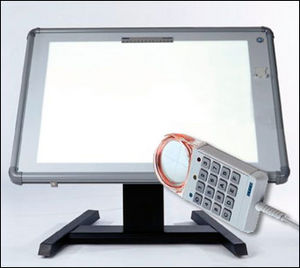Digitizing
Embroidery Digitizing is the art of taking a logo or any graphical image and converting it into embroidery points. Generally when a digitizer digitizes an embroidery design, they are using a computer software program and using its tools to plot these points. Those points are then converted into stitches by the software and then saved to an embroidery software format which the embroidery machine can read. The final embroidery file tells the machine in which direction to move the frame for each stitch.
History
Before embroidery machines where run by computers, all embroidery was done by hand by moving the garment manually as the needle moved up and down creating the stitch. Around the late 1970s Embroidery Machines were then equipped with X and Y motors which moved the garments left and right and back and forward. The X and Y movements were controlled by software programs also known as digitized designs or digitized logos.
In the late 1970s till around the late 1990s, all digitizing was done on a large tablet with a puck. The large tablet was generally about the size of a small dinner table. The tablets were typically white and on a stand so that they would be stood up at a slight angle where the digitizer could sit in front of it. The tablets look similar to a white board. The tablets were attached to a computer. An embroidery artist would then hand draw the logo by about 10 times the size of the final embroidery product, usually on heavier stock paper. Using colored pencils the artist might also color in parts of the drawing so the digitizer knew what colors each part of the logo was supposed to be. The artist might also pencil in various notes on the paper for the digitizer. Due to the width of an embroidery stitch or embroidery thread, very fine detail is hard to achieve. A good embroidery artist would remove or enlarge parts of the image that were too small for embroidery stitches. They might also add reference lines or marks for the digitizer.
Automatic and Manual Digitizing
Some embroidery software packages have Automatic Digitizing features. Automatic Digitizing is the act of taking a computer graphic image and converting it to stitches automatically. Traditionally the stitches are created manually on the computer software plotting each point in the same direction or same steps that the digitizer would want the machine to run. Automatic digitizing software will automatically plot all the points by vectoring the image. What this means is that the automatic digitizing software will look at the graphic and attempt to find common shapes such as boxes, rectangles, and curves. For example, the letter T generally is made of 2 rectangles. One rectangle goes up and down and another one goes to the left and right. Automatic digitizing software will attempt to find these shapes and then process them into stitches. A digitizer who is manually digitizing an image will do the same thing. As humans we can easily recognize these basic shapes. If a digitizer is manually digitizing an image, they will tell the software where all these points are at by manually plotting all the points. Once these basic shapes are plotted or 'digitized', the software can fill them in with stitches.
